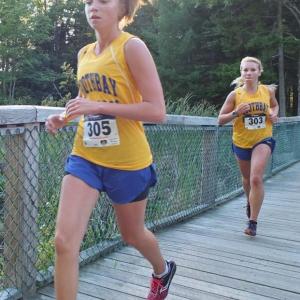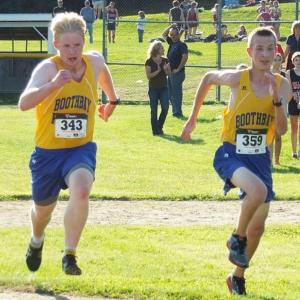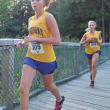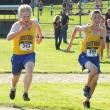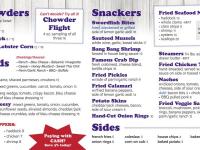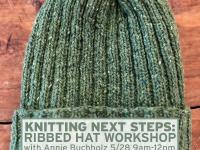First home meet
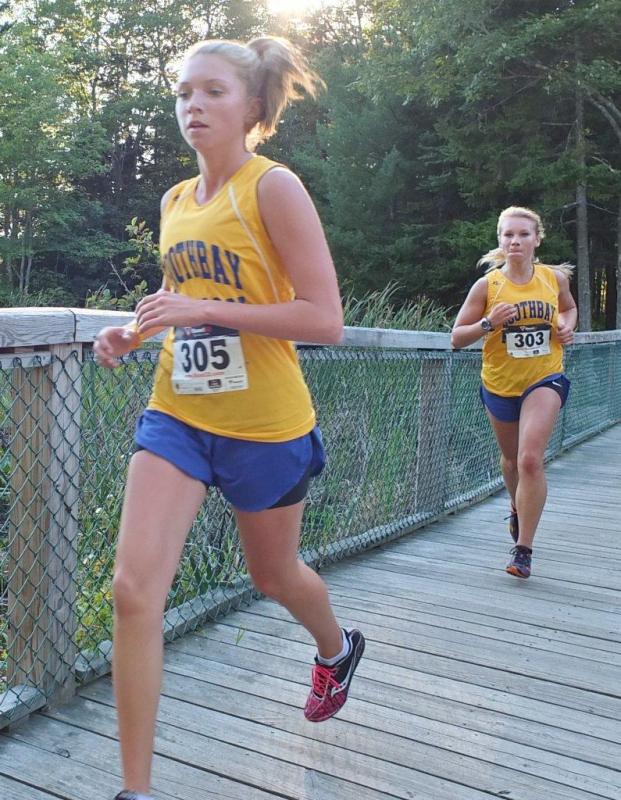 Hannah Morley and Morgan Crocker cross the bridge at Penny Lake. Morley and Crocker finished second and fifth place respectively at the first home meet of the season. Below, Brady Duncan and David Machon sprint toward the finish line. The boys team earned third place out of five MVC teams at the September 12 meet hosted by Boothbay Region High School. RYAN LEIGHTON/Boothbay Register
Hannah Morley and Morgan Crocker cross the bridge at Penny Lake. Morley and Crocker finished second and fifth place respectively at the first home meet of the season. Below, Brady Duncan and David Machon sprint toward the finish line. The boys team earned third place out of five MVC teams at the September 12 meet hosted by Boothbay Region High School. RYAN LEIGHTON/Boothbay Register
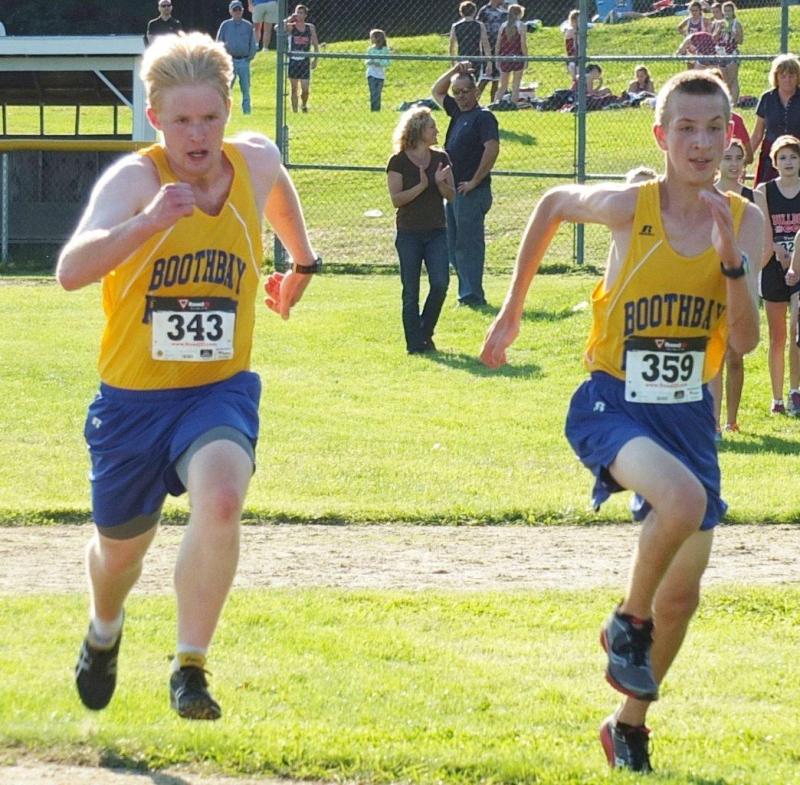 Brady Duncan and David Machon sprint toward the finish line. The boys team earned third place out of five MVC teams at the September 12 meet hosted by Boothbay Region High School. RYAN LEIGHTON/Boothbay Register
Brady Duncan and David Machon sprint toward the finish line. The boys team earned third place out of five MVC teams at the September 12 meet hosted by Boothbay Region High School. RYAN LEIGHTON/Boothbay Register
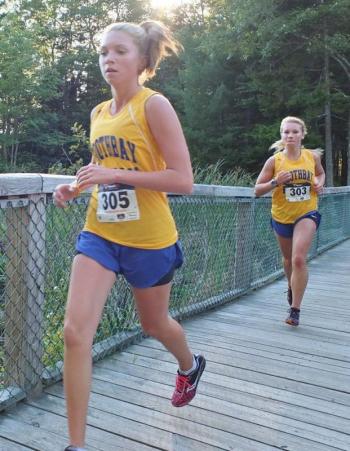 Hannah Morley and Morgan Crocker cross the bridge at Penny Lake. Morley and Crocker finished second and fifth place respectively at the first home meet of the season. Below, Brady Duncan and David Machon sprint toward the finish line. The boys team earned third place out of five MVC teams at the September 12 meet hosted by Boothbay Region High School. RYAN LEIGHTON/Boothbay Register
Hannah Morley and Morgan Crocker cross the bridge at Penny Lake. Morley and Crocker finished second and fifth place respectively at the first home meet of the season. Below, Brady Duncan and David Machon sprint toward the finish line. The boys team earned third place out of five MVC teams at the September 12 meet hosted by Boothbay Region High School. RYAN LEIGHTON/Boothbay Register
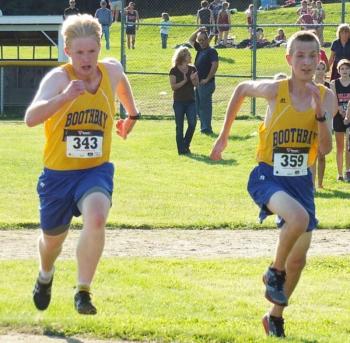 Brady Duncan and David Machon sprint toward the finish line. The boys team earned third place out of five MVC teams at the September 12 meet hosted by Boothbay Region High School. RYAN LEIGHTON/Boothbay Register
Brady Duncan and David Machon sprint toward the finish line. The boys team earned third place out of five MVC teams at the September 12 meet hosted by Boothbay Region High School. RYAN LEIGHTON/Boothbay Register
The Boothbay Region High School boys and girls cross-country teams held their only home meet of the season on September 12, hosting four other Mountain Valley Conference teams, Hall-Dale, Monmouth, Lisbon, and St. Dom's. Boothbay's Sophia Thayer and Robert Campbell reined in first place victories on Seahawk turf that featured one of the more challenging courses in the MVC circuit.
The girls team finished second place behind St. Dom's, led by another strong performance from the Seahawks top three runners. Thayer captured her second consecutive win of the season, crossing the finish line in a time of 21:56. The win further solidifies Thayer’s reputation as a runner to watch out for. Arriving at the finish line only 12 seconds behind Thayer was up-and-coming freshmen runner Hannah Morley, who finished second overall. Placing fifth was sophomore Morgan Crocker who consistently delivers a powerful performance boosting the Lady Seahawks' team score. Also contributing to the team’s strong finish was Maya Schwehm, Genevieve Taylor and Allison Crocker.
The boys team placed third overall in a tight match up between Hall-Dale and Monmouth Academy. Campbell captured his first overall win of the season finishing in a time of 19:06.
Despite having the first five Boothbay runners finishing in the top 20, the Seahawks were defeated by Monmouth Academy by two points (The top three boys teams were separated only by a five-point difference). The top five Boothbay finishers were Campbell, Benn Scully (sixth) Alex Owen (eleventh), Matt Burnham (thirteenth) and Jack Hasch (nineteenth) out of a field of 52 competitors. (See video below)
Cross-country insight
During the busy fall sports schedule, the sport of cross-country running still remains a mystery to many high school sports fans who have little to no understanding of the rules, point scoring, and team dynamics that come into play throughout the season.
In sports, people generally think the team with the higher score wins. In cross-country, it’s the exact opposite. Like the game of golf, the lower score prevails. In order for a team to collect points, at least five active runners must compete at a meet.
After the race, the first five competitors to finish are the scoring members who are added up based on the place they earn. For example, in the last home meet, the top five Seahawks to cross the finish line were given scores (place finished) and the scores are added up by their respective place: 1+6+11+13+19 = 50. The team score is 50.
Occasionally it comes down to the wire and teams are defeated by a mere one-point difference. During the September 5 Winthrop meet, the girls team squeaked by Monmouth Academy for the victory, 38 points to the Mustang’s 39. In the event of a tie, the team with the first non-scoring member to finish the race claims the win.
As the season progresses, athletes work toward earning their spot on the varsity team, which competes at the championship races. Each team is allowed to submit seven runners eligible for scoring at the regional and state meets.
Every year Coach Scott tells his team to treat the first eight weeks as tryouts for the varsity squad.
“Most of the time, the top seven sort themselves out. Every now and then I run into the seventh and eighth runners being really close. I ultimately make the decision as to who I think will be the most dependable for the big races,” he said.
There are no official team standings in cross-country. All teams simply show up to the conference championships and the fastest team takes home the trophy.
For individual contests, runners strive to make the All-Conference first and second team by finishing in the top 14 places. Last year returning senior runner Alex Owen finished eighth place at the MVC championships, earning him a spot on the second All-Conference team, along with former Seahawks Chase Brown, who placed thirteenth at the New England Championships, and Tom Brown, a member of the All-Conference first team.
The next article will explain how a runner learns a pace.
Event Date
Address
United States

